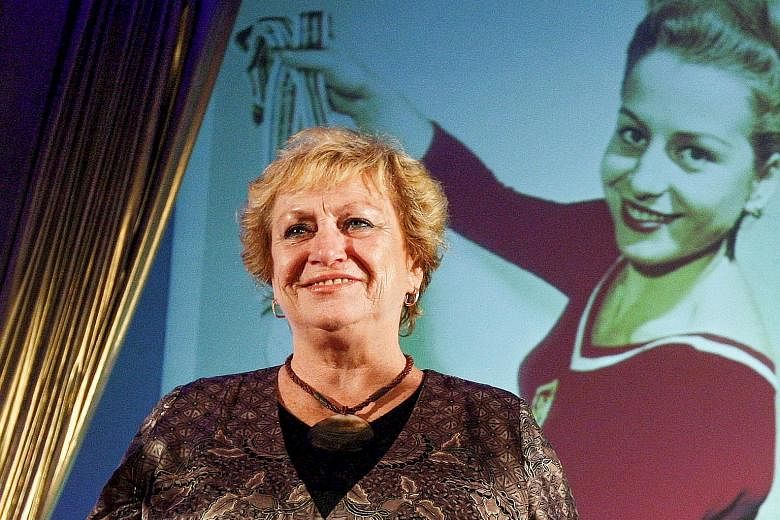LONDON • When Simone Biles won four golds in last month's Rio de Janeiro Olympics, she was the latest in a line of charismatic female gymnasts whose acrobatics have captured imaginations far beyond the world of sport.
Nadia Comaneci (in 1976) and Olga Korbut (in 1972) are two famous examples, but Vera Caslavska, who died aged 74 last Monday, was the first and possibly the bravest.
The Czech's seven Olympic golds, won in Tokyo in 1964 and Mexico City in 1968, included back-to-back triumphs as best all-around gymnast, an achievement matched only once in Olympic history.
Her second all-around gold was won by a points margin unparalleled until Biles' triumph this year, and marked the culmination of a four-year period in which Caslavska won 19 individual golds at major international championships.
She remains the only gymnast, male or female, to have won Olympic gold in every individual event.
However, what made her a global celebrity was her character. Vivacious and attractive, with a winning smile and a mass of blond hair held back with a wide band, Caslavska was an audience darling, especially in Mexico City, where she performed her floor routine to "The Mexican Hat Dance".
According to Bart Conner, an Olympic gold medallist in 1984, Caslavska "was one of the most dominant gymnasts of her time, balanced in all the events and completely comparable to someone like Simone Biles".
"She was one of the first to introduce a strong, acrobatic, athletic style to gymnastics, which previously had been more dance-oriented," added Conner, who is now the chairman of the International Gymnastics Hall of Fame.
The third daughter of a grocer from the Karlin district of Prague, Caslavska showed early athletic promise but initially tried to channel her talents into ballet and figure skating.
At 14, she was taken under the wing of Eva Bosakova, the leading female gymnast in then Czechoslovakia. Within four months, she was competing internationally.
By 1958, aged 16, she was good enough to be taken to the world championships in Moscow, where the Czech team won a silver. In 1960, the team also clinched a silver in the Rome Olympics.
It was in Tokyo four years later that she established herself as the greatest gymnast of her generation - notwithstanding a fall from the asymmetric bars.
Her three gold medals (vault, balance beam and all-around) and team silver barely began to reflect her dominance.
In 1968, in Mexico City, Caslavska turned in a performance for the ages, winning golds in the vault, all-around, floor and uneven bars, and silvers in the balance beam and the team competition.
She shared the gold in the floor exercise with Larisa Petrik of the Soviet Union, who moved up from second place when Soviet judges revised their scores at the last minute.
"While the Soviet gymnasts were already in Mexico City, adjusting to the altitude and the climate, I was hanging from trees, practising my floor exercise in the meadow in front of the cottage and building calluses on my hands by shovelling coal," she told The Los Angeles Times in 1990. "Then I went to Mexico and won the gold medal."
Caslavska became the central figure of a political drama when she ascended the podium to receive her gold medal for the floor exercise.
When the Soviet national anthem was played for Petrik, Caslavska responded by lowering her head and looking away, an act of defiance that put her career on ice.
A few months later, while in the United States to attend an Amateur Athletic Union ceremony honouring her as the top female athlete in the world for 1968, she said: "We all tried harder to win in Mexico because it would turn the eyes of the world on our unfortunate country."
Immediately after the 1968 Games, she married a fellow Czech Olympian, middle-distance runner Josef Odlozil.
The marriage ended in divorce. He died in 1993 from wounds inflicted by the couple's son, Martin, during a fight in a Prague disco.
Her son survives her, as does her daughter, Radka.
Indeed, the post-Olympic years were difficult for Caslavska. She once said: "After ascending the summit of Olympus, the journey downward did not exactly follow the well-trodden path. It consisted of rocks, gorges and a bottomless pit."
She was investigated by the Czech government for being an "unhealthy influence", was barred from competing and was denied employment as a coach in her country. From 1970 to 1981, she coached the Mexican national team.
Yet, after the end of decades of Communist Party rule, she was appointed an adviser to President Vaclav Havel on sports and social issues, and was also chairperson of the Czechoslovak Olympic Committee.
THE GUARDIAN, NEW YORK TIMES

